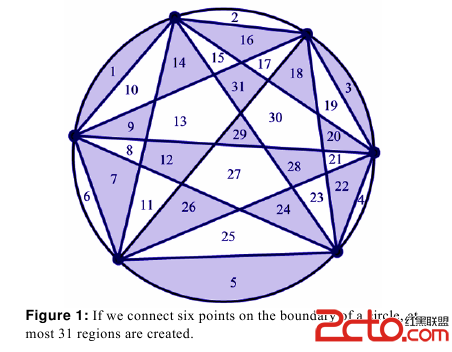Description
Combinatorics is a branch of mathematics chiefly concerned with counting discrete objects. For instance, how many ways can you pick two people out of a crowd ofn people? Into how many regions can you divide a circular disk by connectingn points on its boundary with one another? How many cubes are in a pyramid with square layers ranging from1×1 to n×n cubes?

Many questions like these have answers that can be reduced to simple polynomials inn. The answer to the first question above is
n(n - 1)/2, or (n![]() 2 -n)/2.
The answer to the second is (n
2 -n)/2.
The answer to the second is (n![]() 4 - 6n
4 - 6n![]() 3
+ 23n
3
+ 23n![]() 2 - 18n + 24)/24. The answer to the third isn(n
+ 1)(2n + 1)/6, or (2n
2 - 18n + 24)/24. The answer to the third isn(n
+ 1)(2n + 1)/6, or (2n![]() 3 + 3n
3 + 3n![]() 2
+ n)/6. We write these polynomials in a standard form, as a polynomial with integer coefficients divided by a positive integer denominator.
2
+ n)/6. We write these polynomials in a standard form, as a polynomial with integer coefficients divided by a positive integer denominator.
These polynomials are answers to questions that can have integer answers only. But since they have fractional coefficients, they look as if they could produce non-integer results! Of course, evaluating these particular polynomials on a positive integer always results in an integer. For other polynomials of similar form, this is not necessarily true. It can be hard to tell the two cases apart. So that, naturally, is your task.
Input
The input consists of multiple test cases, each on a separate line. Each test case is an expression in the form(P)/D, where
P is a polynomial with integer coefficients andD is a positive integer denominator.
P is a sum of terms of the form
Cn![]() E, where the coefficient
C and the exponent E satisfy the following conditions:
E, where the coefficient
C and the exponent E satisfy the following conditions:
See the sample input for details.
Input is terminated by a line containing a single period.
Output
For each test case, print the case number (starting with 1). Then print `Always an integer' if the test case polynomial evaluates to an integer for every positive integern. Print `Not always an integer' otherwise. Print the output for separate test cases on separate lines. Your output should follow the same format as the sample output.
Sample Input
(n^2-n)/2 (2n^3+3n^2+n)/6 (-n^14-11n+1)/3 .
Sample Output
Case 1: Always an integer Case 2: Always an integer Case 3: Not always an integer 題意:給定一個形如P/D的多項式,判斷它是否在所有正整數取到整數值 思路:劉汝佳入門經典的例題,分析太長,直接給結論吧:P(1),P(2)..P(k+1)都是D的倍數,最後帶入n檢查就行了,n的范圍是1-k+1#include#include #include #include typedef long long ll; using namespace std; const int maxn = 110; int c[maxn], e[maxn], p; int tot, len, l, tmp; char str[10001]; int flag; ll pow_mod(ll a, ll p, ll n) { ll tmp = 1; while (p) { if (p & 1) tmp = (tmp * a) % n; p >>= 1; a = (a * a) % n; } return tmp; } void cal(int s, int a, int b) { int k, cs = 0, es = 0; for (k = a; k <= b; k++) if (str[k] == 'n') break; for (int i = a; i < k; i++) cs = cs * 10 + str[i] - '0'; if (cs == 0) cs = s; else cs *= s; for (int i = k+2; i <= b; i++) es = es * 10 + str[i] - '0'; if (k <= b && es == 0) es = 1; c[tot] = cs; e[tot++] = es; } int main() { int cas = 1; while (scanf("%s", str) && str[0] != '.') { len = strlen(str); l = tot = 0; if (str[1] == '-') l = 2; else l = 1; for (int i = l; i < len; i++) { if (str[i] == '+' || str[i] == '-' || str[i] == ')') { if (str[l-1] == '-') cal(-1, l, i-1); else cal(1, l, i-1); l = i+1; } if (str[i] == '/') { p = 0; for (int j = i+1; j < len; j++) p = p*10 + str[j] - '0'; break; } } flag = 1; for (int i = 1; i < 200; i++) { tmp = 0; for (int j = 0; j < tot; j++) tmp = (tmp + (c[j]%p)*pow_mod(i, e[j], p)) % p; if (tmp) { flag = 0; break; } } if (flag) printf("Case %d: Always an integer\n", cas++); else printf("Case %d: Not always an integer\n", cas++); } return 0; }